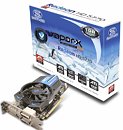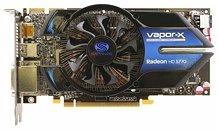Monday, December 7th 2009

Sapphire Unveils HD 5770 Vapor-X
Sapphire expanded its Radeon HD 5700 series with the Sapphire HD 5770 Vapor-X. This release comes around a month after the HD 5750 Vapor-X, and resembles it in having the same GPU cooler: a GPU contact block with a Vapor chamber acts as a large heatpipe, uniformly conveying heat to the heatsink above it, which is cooled by a fan. Unlike the HD 5750 Vapor-X which comes with a blue reference PCB, this one retains the black reference one, with the cooler being the only noticeable change.
The Radeon HD 5770 is based on the 40 nm Juniper GPU. It is DirectX 11 compliant, and has 800 stream processors, along with 1 GB of memory installed across a 128-bit GDDR5 interface. It also supports the ATI Eyefinity technology that allows users to scale a display head across three physical displays. Connectivity includes two DVI-D, and one each of HDMI and DisplayPort. Sapphire also gave it a modest factory overclock, with the core running at 860 MHz (vs 850 MHz reference), while the memory stays at 1200 MHz (4.8 GHz effective). It is priced around 145 EUR.
The Radeon HD 5770 is based on the 40 nm Juniper GPU. It is DirectX 11 compliant, and has 800 stream processors, along with 1 GB of memory installed across a 128-bit GDDR5 interface. It also supports the ATI Eyefinity technology that allows users to scale a display head across three physical displays. Connectivity includes two DVI-D, and one each of HDMI and DisplayPort. Sapphire also gave it a modest factory overclock, with the core running at 860 MHz (vs 850 MHz reference), while the memory stays at 1200 MHz (4.8 GHz effective). It is priced around 145 EUR.


32 Comments on Sapphire Unveils HD 5770 Vapor-X
There is nothing under the shroud. A "vapour camber" is most effective when shifting large amounts of heat relatively large distances... like on the batcar, there are fins all along... and the vapour chamber is "equivalent" to a a whole bunch of heatpipes moving the heat to all points along the large fin arrangement, but a lot easier and cheaper to manufacture.
But in this example, the heat isnt being taken anywhere other than staying under the main fan. You could quite easily achieve this using a solid copper baseplate. I guess the question comes down to how much more effective the nanospreader is (small vapour chamber) than copper. It's probably not as heavy. And may be more effective. We'll have to see.
IMO this is more marketing spin. I doubt it will be more efficient at cooling that the egg, OTHER THAN it has a larger fan. The "nanospreader", in this instance, adds very little. I do agree that vapour chambers are very effective with the larger cooler arrangements.
Nice article here: www.xbitlabs.com/news/coolers/display/20081020145721_ATI_Looking_Forward_More_Advanced_Cooling_Technologies_for_Graphics_Cards.html
To the noise anything over 50% is quite loud on the original cooler (irritating to me especially when I have 2 of them going)
And to the Vapor X cooler, I had several coolers to try out on the 4870s, The Vapor X was at least 5-6C cooler than the Heat tube cooler (with the smashed closed heat tubes) Notice the heat tube coolers are now gone and there are quite a few Vapor X coolers on the new cards...(looks like Sapphire figured it out too)You are SO wrong on every point....(and because of posts like yours misinformation is spread all over the internet, its fine to have an opinion and express it but make sure you mention its just "ur opinion")
Steel/copper not alum.
And what good are heat tubes when they are smashed closed?
The Vapor X is a superior cooler, its more compact, more efficient and quieter as well.
I just bought one from newegg and posted the first review on their site:
www.newegg.com/Product/Product.aspx?Item=N82E16814102868&cm_re=5770-_-14-102-868-_-Product
For me the cooler works great: 35C to 60C temps. And, nearly totally silent even under full load.
Does anyone else went beyond 1010 for GPU? What voltage?
Personally I wont put more than 1300mV...